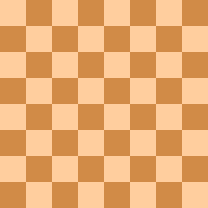| a | b | c | d | e | f | g | h | ||
| 8 |  | 8 | |||||||
| 7 | 7 | ||||||||
| 6 | 6 | ||||||||
| 5 | 5 | ||||||||
| 4 | 4 | ||||||||
| 3 | 3 | ||||||||
| 2 | 2 | ||||||||
| 1 | 1 | ||||||||
| a | b | c | d | e | f | g | h | ||
Dark chess (also known as Fog of War chess) is a chess variant with incomplete information, similar to Kriegspiel. It was invented by Jens Bæk Nielsen and Torben Osted in 1989. A player does not see the entire board – only their own pieces and the squares that they can legally move to.
Rules
The goal of this chess variant is not to checkmate the king, but to capture it. A player is not told if their king is in check. Failing to move out of check, or moving into check, are both legal, and can obviously result in a capture and loss of the game.
Each player views a different version of the board, on which they can only see their own pieces, and the squares where these pieces can legally move, as well as any opponent pieces on those squares (which must therefore be capturable). It is indicated to the player which squares are hidden, so a hidden square can never be confused with a visible empty square. As an example, it is always clear when an enemy piece is directly in front of a pawn, because that square will be hidden (as capturing it is not a legal move for the pawn to make).
En passant capture is allowed; the threatened pawn and the square it moved through are both visible to the capturing player, but only until the end of the turn. Unlike standard chess, castling is allowed out of check, into check, and through the positions attacked by enemy pieces.
This chess variant is best played on online chess servers. In September 2020, Dark chess was the most popular variant on Chess.com. For playing over-the-board, three chess sets and a referee are needed, just as in Kriegspiel.
There are some minor differences in the rules on different servers:
- SchemingMind: the player does not see what is in front of their pawns, but knows if the position is occupied or not.
- Chess.com (known as "Fog of War chess"); the player does not see what is in front of their pawns, but knows if the position is occupied or not; pawn promotions remain unknown for the opponent. Before November 5, 2021 when a pawn could be taken en passant, the pawn was not visible, but the en passant square was lit up.
Variations
Generally, because basic Dark chess rules are universal with respect to its "parent" classical variant, any 2-player chess variant may be played "in dark". SchemingMind provides some of the variations.
- Dark chess (checkmate) – standard rules of check apply (a player is notified when its king is in check, and the king cannot move into check). The goal in this variation is the same as in standard chess — to checkmate the king.
- Dark chess (check) – a player is notified when the king is in check, but the king can remain in check after a move. The goal in this variation is the same as in standard dark chess – to capture the king.
- Dark crazyhouse – combination of crazyhouse and dark chess.
- Dark suicide – combination of suicide and dark chess.
- Sun Tzu chess – combination of Double Fischer Random Chess (like Chess960, but with different positions for White and Black), crazyhouse and dark chess. Pieces can be dropped onto any possible square on the board (like crazyhouse). This chess variant was invented in 2005 by John Kipling Lewis.
- Lao Tzu chess – like Sun Tzu, but pieces can only be dropped on seen squares. Also invented in 2005 by John Kipling Lewis.
- Dark Omega chess – combination of Omega Chess and dark chess.
- Dark Seirawan chess – combination of Seirawan chess and dark chess.
Gameplay
Dark chess has a strong strategic flavor. Planning and strategy, as well as some psychological reasoning, are very important; tactics and move searching are not as important as in standard chess.
In this variant, a king should be carefully protected from very dangerous checks by invisible pieces; castling is essential, as the pawns and rook protect the king from invisible pieces. For a queen the most dangerous pieces are knights, which can attack it without becoming visible.
See also
References
- ^ "What is Fog of War chess?". Chess.com. Retrieved April 8, 2021.
- Jason (EnergeticHay) (2020-09-27). "Fog of War: Chess.com's Most Popular Variant". Chess.com. Retrieved 2024-02-08.
- "SchemingMind.com". SchemingMind.com. Retrieved 2024-02-08.
- Dark Omega Chess at GamesByEmail.com
External links
- Dark Chess Strategy guide
- Darkness chess by Jens Bæk Nielsen
- Dark chess by Tall Troll Games
| Chess variants (list) | |||||||||
|---|---|---|---|---|---|---|---|---|---|
| Orthodox rules |
| ||||||||
| Unorthodox rules with traditional pieces |
| ||||||||
| Unorthodox rules using non-traditional pieces |
| ||||||||
| Multiplayer | |||||||||
| Inspired games | |||||||||
| Chess-related games |
| ||||||||
| Software | |||||||||
| Related | |||||||||